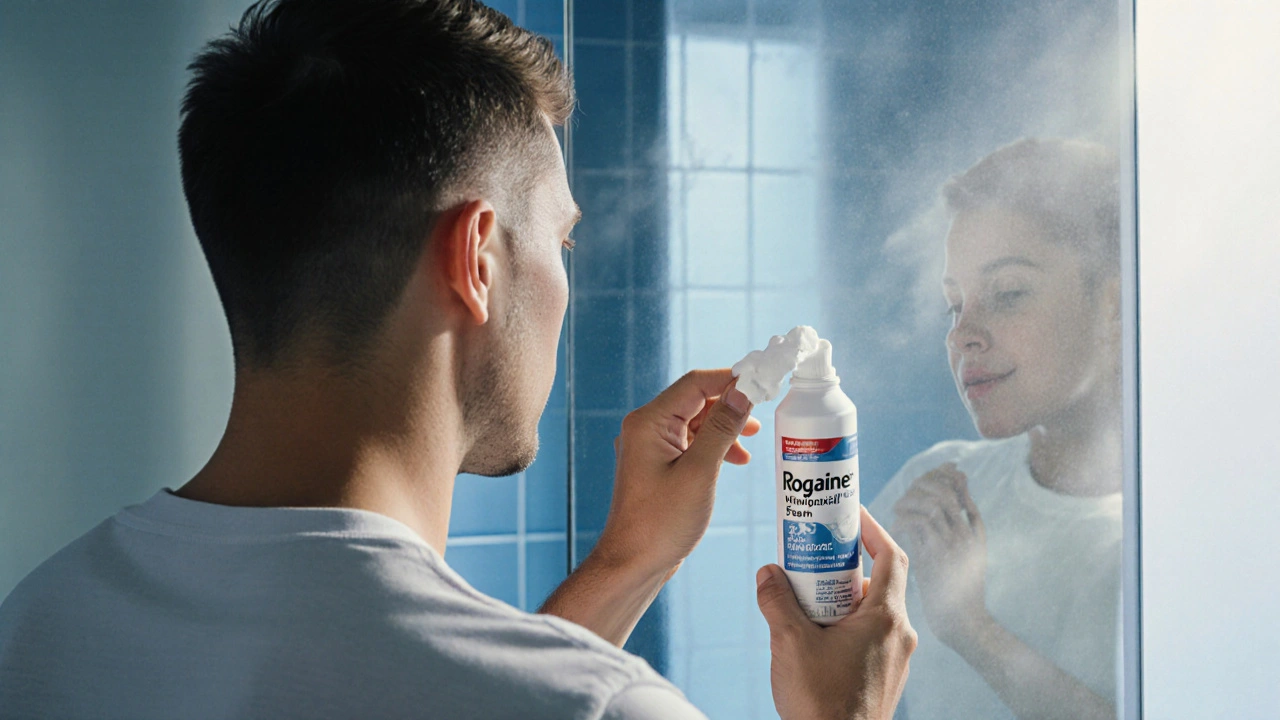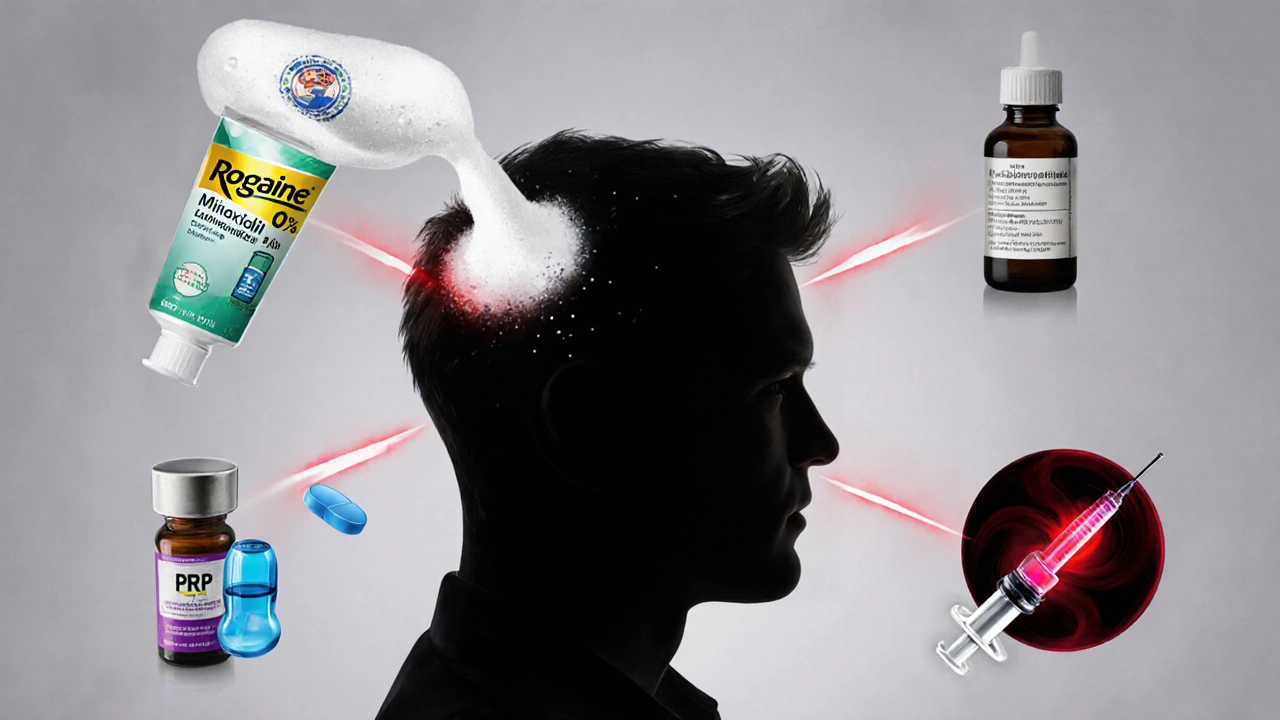
Hair Loss Treatment Decision Guide
Find Your Best Treatment Option
Answer a few questions to get personalized recommendations for hair loss treatments.
Recommended Treatments
Hair loss isn’t just a vanity issue; it can hit confidence hard and push people to research every possible treatment. Among the flood of options, Rogaine 2 often tops the list, but how does it really stack up against other routes like oral meds, lasers, or even surgery? This guide breaks down the science, costs, and real‑world results so you can decide what fits your scalp and budget.
Key Takeaways
- Rogaine 2 delivers a 2% minoxidil foam that’s FDA‑approved for men and works best on early‑stage thinning.
- Generic minoxidil liquid offers the same active ingredient at a lower price but can be messier to apply.
- Finasteride targets the hormonal cause of male pattern baldness and shows higher regrowth percentages, yet carries systemic side effects.
- Low‑Level Laser Therapy (LLLT) and Platelet‑Rich Plasma (PRP) are non‑pharmaceutical options with modest results and higher upfront costs.
- Hair transplant provides permanent density but is invasive, expensive, and not suitable for everyone.
How Rogaine 2 Works
Rogaine 2 is a 2% minoxidil foam approved by the FDA for male pattern baldness. Minoxidil dilates scalp blood vessels, improving nutrient delivery to hair follicles and extending the growth phase (anagen). The foam formulation reduces the oily residue typical of liquid solutions, making daily application less messy. Clinical trials report about 30‑40% of users see visible regrowth after four months of twice‑daily use, with the best outcomes for those under 40 and with vertex‑only thinning.
Consistent use is critical-stopping the foam usually triggers a return to the pre‑treatment state within three to four months. Because the ingredient works locally, systemic side effects are rare, though a few users notice scalp irritation or unwanted facial hair.

Major Alternatives on the Market
Generic Minoxidil is the non‑brand counterpart, typically sold as a 2% or 5% liquid solution. It contains the same active ingredient as Rogaine 2, but the dropper bottle can feel greasy and may cause more skin irritation.
Finasteride (often known by the brand name Propecia) is an oral 1mg tablet that inhibits the conversion of testosterone to dihydrotestosterone (DHT), the hormone that shrinks hair follicles. Studies show 60‑70% of men achieve measurable regrowth, especially on the crown, but the drug can cause sexual dysfunction and requires a prescription.
Low‑Level Laser Therapy (LLLT) devices-headbands, caps, or combs-use red light wavelengths (650‑660nm) to stimulate cellular activity in the follicle. Meta‑analyses suggest a 25‑30% improvement in hair density after 6‑12months, with virtually no side effects, though the equipment can cost $200‑$1,000.
Platelet‑Rich Plasma (PRP) therapy involves drawing a small amount of your own blood, concentrating the platelets, and injecting the plasma into the scalp. Growth factors in PRP may boost follicle health; typical protocols require three sessions over three months, with results lasting 12‑18months for about 30‑40% of patients.
Hair Transplant surgery-Follicular Unit Extraction (FUE) or Follicular Unit Transplantation (FUT)-relocates healthy donor follicles to balding zones. Success rates exceed 90% for permanent coverage, but the procedure can cost $4,000‑$15,000 and needs a skilled surgeon.
Other supportive options include Biotin Supplements, which may improve nail and hair strength for people with a deficiency, and Saw Palmetto, a plant extract thought to mildly block DHT locally. Evidence for both is limited, but they’re low‑cost additions to a broader regimen.
Head‑to‑Head Comparison
| Product | Form | Typical Concentration / Dose | Average Monthly Cost (USD) | FDA Status | Reported Efficacy |
|---|---|---|---|---|---|
| Rogaine 2 | Foam | 2% minoxidil | $30‑$40 | Approved for topical use | 30‑40% visible regrowth |
| Generic Minoxidil | Liquid | 2% or 5% minoxidil | $15‑$25 | Approved for topical use | 28‑38% (similar to Rogaine) |
| Finasteride | Oral Tablet | 1mg daily | $10‑$20 (generic) | Approved for male pattern baldness | 60‑70% hair count increase |
| LLLT Device | Headband/Cap | Red light 650‑660nm, 15min 3×/wk | $200‑$1,000 (one‑time) | Not FDA‑cleared as a drug (device clearance) | 25‑30% density improvement |
| PRP Therapy | Autologous Injections | 3 sessions/yr | $500‑$1,500 per session | Off‑label medical procedure | 30‑40% patient satisfaction |
| Hair Transplant (FUE) | Surgical | 1‑3k grafts | $4,000‑$15,000 (one‑time) | Medical procedure, not a drug | 90+% permanent coverage |
Choosing the Right Option for Your Situation
There’s no one‑size‑fits‑all answer. Here’s a quick decision matrix:
- Early, mild thinning (vertex only): Start with Rogaine 2 or generic minoxidil. The foam’s ease of use makes adherence higher.
- Established crown loss with visible recession: Finasteride adds hormonal control and often doubles the regrowth odds.
- Concerned about pills or systemic side effects: LLLT or PRP give a drug‑free route, though you’ll pay more upfront.
- Desire for immediate, permanent results: Hair transplant is the only surgical cure, but it requires enough donor hair and a qualified clinic.
- Limited budget: Generic minoxidil + biotin can be a starter pack; upgrade later if needed.
Remember that many users combine treatments-e.g., minoxidil foam plus finasteride-to attack hair loss from two angles. If you choose a combo, monitor for scalp irritation and any systemic side effects, and check with a dermatologist.
Common Pitfalls and How to Avoid Them
- Skipping applications: Minoxidil’s effect wanes within weeks of missed doses. Set a daily reminder or keep the product by your toothbrush.
- Expecting instant miracles: Visible regrowth generally appears after 12‑16 weeks. Patience is key.
- Using the wrong concentration: 5% solutions are meant for men; women should stick to 2% to reduce irritation.
- Neglecting scalp health: Excessive styling products can block absorption. Keep the scalp clean and limit heavy gels.
- Self‑diagnosing severe alopecia: If you notice rapid shedding or patchy bald spots, see a dermatologist-underlying conditions like thyroid disease may need treatment.
Frequently Asked Questions
Can I use Rogaine 2 and finasteride together?
Can I use Rogaine 2 and finasteride together?
Yes. The two work via different mechanisms-Rogaine 2 improves follicle blood flow while finasteride lowers DHT levels. Many clinicians prescribe both for synergistic effect, but you should monitor for side effects and keep regular check‑ups.
Is the foam really better than the liquid?
Foam dries faster and leaves less residue, which many users find more comfortable. Efficacy is comparable because the active ingredient is identical. If you dislike the feel of liquid, foam is a solid alternative.
How long does it take to see results?
Most users notice reduced shedding after 2‑3months and visible growth after 4‑6months. Full results may require up to a year of consistent use.
Are there any long‑term risks with minoxidil?
Long‑term topical use is generally safe. Rare side effects include scalp irritation, rapid heart rate, or unwanted facial hair. If you experience systemic symptoms, stop use and consult a doctor.
Can women use Rogaine 2?
Women are usually advised to use the 2% minoxidil liquid or foam formulated specifically for female pattern hair loss. Higher concentrations (5%) can cause more irritation and are not FDA‑approved for women.
Bottom line: if you’re just starting to see a thinning crown, Rogaine 2 offers a proven, low‑cost entry point backed by FDA approval. As the pattern progresses or if you prefer a prescription‑strength boost, adding finasteride or exploring laser/PRP options can raise your odds of fuller hair. Whatever path you choose, stick to the regimen and give the treatment time to work-hair growth isn’t instant, but patience plus the right product can make a noticeable difference.

Looks solid, thanks for the breakdown 🙂
The comparison does a good job of laying out cost versus efficacy; however, keep in mind that individual response varies widely, especially with topical agents. Rogaine 2’s 2% concentration is indeed FDA‑approved, but its 30‑40% success rate means many users will see minimal change. If you’re looking for higher regrowth percentages, adding an oral DHT blocker like finasteride can push efficacy into the 60‑70% range. Remember to monitor for systemic side effects-sexual dysfunction, for instance-when combining therapies; a dermatologist’s guidance is essential.
Good points! Just a heads‑up: staying consistent with the foam is key-missing doses will drop those numbers fast. Also, a gentle scalp massage can boost absorption, no extra cost. Keep the vibe positive, you’ll see results sooner.
I appreciate the clear breakdown of each option, especially the note on how the foam feels less greasy than the liquid.
Exactly! For anyone on a tighter budget, the generic liquid gives the same active ingredient-just watch out for that oily feeling 🙃. And don’t forget to clean the applicator tip regularly; it prevents buildup and irritation!!!
One thing to add: while finasteride offers higher efficacy, some patients report persistent side effects even after discontinuation. It’s worth discussing a wash‑out period with your physician before committing long‑term.
All this pharma stuff is just a cover for big pharma’s profit scheme.